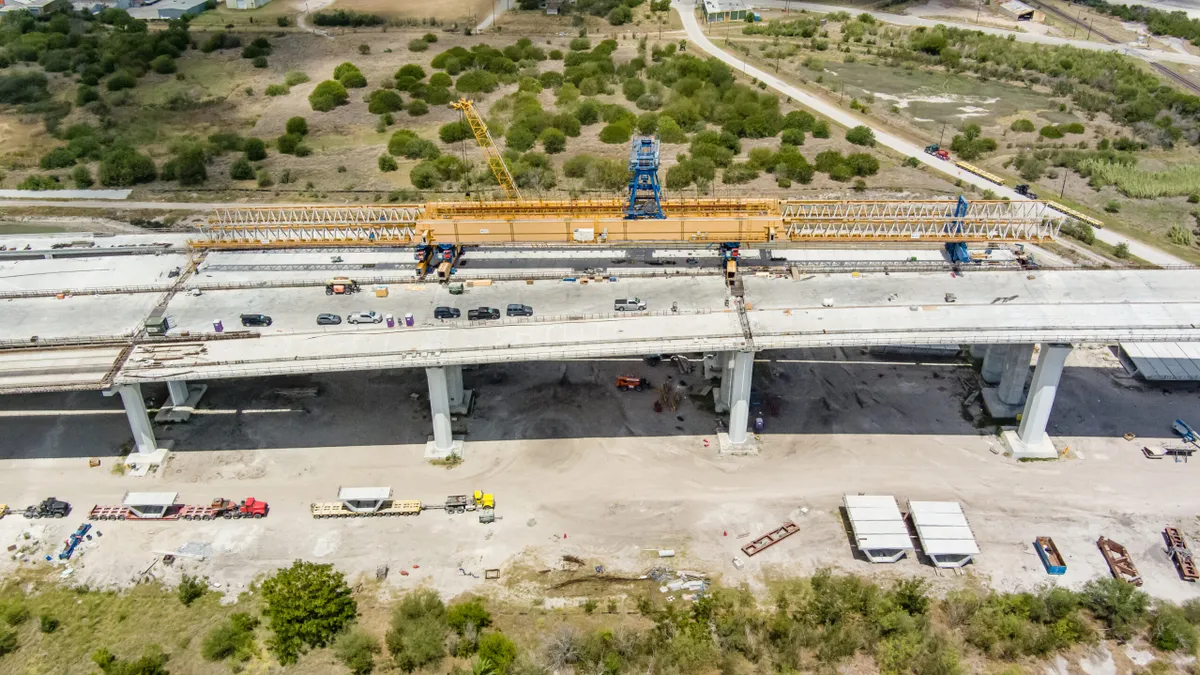UPDATE: March 15, 2023: Four out of five safety concerns that Texas DOT raised with contractor Flatiron/Dragados and engineer Arup on the new Harbor Bridge project in Corpus Christi, Texas, have been resolved, according to the agency’s website. A third-party review by International Bridge Technologies flagged the issues in April 2022.
In addition, the contractors are making progress on the final issue, uplift at intermediate piers, and the agency expects it to be resolved soon as well.
“While not yet resolved, FDLLC, Arup, TxDOT and IBT are exchanging information and anticipate acceptance of [a] design solution in the next few weeks,” the website reads. “This portion of the bridge has not yet been constructed; therefore, no field corrections are needed.”
To address the other issues, the contractor has agreed to extend the footings on the north and south pylons and add additional drilled shafts, according to Texas DOT. The contractor is also adding rebar at connections between delta frames and precast concrete units, roughening concrete surfaces and adjusting crane placements to account for high winds.
Original story continues below.
Dive Brief:
- Some construction on the Harbor Bridge in Corpus Christi, Texas — where work was shut down over safety concerns earlier this summer — will resume as early as next week, following the resolution of one of five key design issues.
- Texas DOT and contractor Flatiron/Dragados announced during a press tour of the jobsite on Oct. 28 that the redesign of the delta frames has been approved, according to the Corpus Christi Caller Times. The new designs included additional steel on parts of the frames.
- Initially scheduled for completion in 2020, the nearly $1 billion project is now tentatively set to finish in 2025, Texas DOT said, and a more precise timeline will be released when the rest of the design issues are resolved. Still outstanding are alleged design flaws in the main cable-stayed portion of the bridge and where cranes will be placed while it’s being built.
Dive Insight:
In early August 2022, Texas DOT warned that the project had design flaws so significant that “the bridge would collapse under certain load conditions” if it were finished per the current design. It cited a 2020 independent review that had identified a series of design and construction flaws, as well as the contractors’ “lack of responsiveness” to its concerns first raised in April.
Flatiron/Dragados, however, said its design work is “fully compliant with the terms of the comprehensive development agreement” and questioned why Texas DOT had allowed so much of the bridge to be built even though it had identified problems much earlier.
An Arup-CFC joint venture took over in July 2020 the design and engineering work FIGG Bridge Engineers had started. Texas DOT had fired FIGG after a National Transportation Safety Board report found the engineer’s designs were the “probable cause” in a 2018 pedestrian bridge collapse at Florida International University in Miami that killed six people.
Texas DOT paused work on the Harbor Bridge in July 2022, and in mid-August, it issued a notice of default and threatened to fire the contractors if several key elements were not reworked. By the end of the month, Flatiron/Dragados committed “to do whatever needs to be done” to address the agency’s concerns and complete the project, and Texas DOT said exchanges became more productive after that. The joint venture has proposed solutions to the safety issues and the Texas DOT is currently reviewing them.
Calculating the costs
Flatiron/Dagados will pay for the redesigns and repairs, but the final cost of the adjustments is not yet known. During a Sept. 6 hearing, Texas DOT Executive Director Marc Williams said the agency plans to exercise more oversight on projects like the Harbor Bridge in the future.
The project involves building the bridge structure and about 6.5 miles of roadway on U.S. 181, which spans the Corpus Christi Ship Channel off of the Gulf of Mexico. In addition to being safer for users than the old Harbor Bridge, officials said the greater clearance on the new span will allow larger ships to pass through and enable the Port of Corpus Christi to compete with other Gulf Coast deep water ports.
As of the press conference Friday, the legal ramifications triggered by Texas DOT’s August notice of default to Flatiron/Dragados are still in effect, meaning the agency can remove the contractor without issuing another notice. Per an Oct. 6 agreement between the two parties, it will remain in place until Flatiron/Dragados initiates work to address the design concerns to Texas DOT’s satisfaction.













